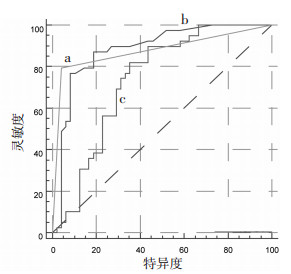Diagnostic efficiency of ADA and LDH in pleural effusion and T-SPOT.TB in peripheral blood for tuberculous pleurisy
-
+ English摘要:目的
探讨腺苷脱氨酶(adenosine deaminase,ADA)、乳酸脱氢酶(lactate dehydrogenase,LDH)水平以及外周血结核感染T淋巴细胞酶联免疫斑点试验(T-SPOT.TB)对结核性胸膜炎的诊断价值。
方法回顾性分析40例结核性胸膜炎患者和48例非结核性胸膜炎患者的外周血T-SPOT.TB检测值和胸腔积液的ADA、LDH水平,分析三者的受试者工作特征曲线(receiver operating characteristic curve,ROC)。
结果非结核性胸膜炎组患者ADA、LDH、TSPOT.TB和三项联合检测所得阳性率均远低于结核性胸膜炎组患者,差异有统计学意义(P < 0.01);结核性胸膜炎组患者中,三项联合检测的阳性率最高,达95.0%。非结核性胸膜炎组四类检测方法所得阳性率差异有统计学意义(P < 0.01),其中三项联合检测所得阳性率仅有2.08%(1例)。结核性胸膜炎组胸腔积液中LDH水平、ADA水平中位数均高于非结核性胸膜炎组,差异有统计学意义(P < 0.01);ADA和T-SPOT.TB对应的ROC曲线下面积等大,且大于LDH对应面积;T-SPOT.TB的ROC曲线最靠近左上角;诊断结核性胸腔积液特异度依次为:T-SPOT.TB > ADA > LDH,灵敏度依次为:ADA > T-SPOT.TB > LDH。
结论TSPOT.TB、ADA和LDH检测对结核性胸膜炎的快速诊断具有重要的临床价值,又以T-SPOT.TB诊断效能最优。
-
胸腔积液(pleural effusion)是指体液在胸膜腔的异常积聚,常继发于结核性疾病、恶性肿瘤和感染等疾病,结核性胸膜炎是胸腔积液常见的病因之一,目前对其鉴别和确诊仍比较困难。胸腔镜下组织活检的诊断阳性率可达到95%,但此项检查对患者创伤较大,风险较高;传统细菌检查方法缓慢,且细菌培养阳性率不足25%[1]。国内外相关研究多是通过病史、临床表现、影像学和胸腔积液检查或诊断性治疗反应来进行诊断,存在一定的局限性。
近年来,外周血结核感染T淋巴细胞酶联免疫斑点试验(T-SPOT.TB)广泛用于肺外结核及痰阴、菌阴结核的诊断,对潜伏性结核感染、活动性或肺外结核都有较好的诊断效能[2-3]。本研究拟对患者胸腔积液的腺苷脱氨酶(adenosine deaminase,ADA)水平、乳酸脱氢酶(lactate dehydrogenase,LDH)水平和外周血T-SPOT.TB检测结果及其受试者工作特征曲线(receiver operating characteristic curve,ROC)进行联合分析,以确定ADA、LDH、T-SPOT.TB的最佳临界值,并评估其单独或组合的诊断效能。
1. 资料与方法
1.1 一般资料
选取2016年8月—2018年3月安徽省职业病防治院收治的伴有胸腔积液的住院患者88例,分为结核性胸膜炎组和非结核性胸膜炎组。
结核性胸膜炎组:患者40例,其中男29例,女11例,平均年龄(51.5 ± 26.6)岁,胸水结核分枝杆菌培养均为阴性;经临床、组织病理学、影像学等诊断确诊为结核病。
非结核性胸膜炎组:患者48例,其中男36例,女12例,平均年龄(67.2 ± 15.6)岁。含恶性胸腔积液20例(含腺癌4例,肺癌11例,胃癌1例,其他恶性肿瘤4例),均经组织病理活检证实;非结核感染性胸腔积液28例(含肺炎旁胸腔积液15例,尘肺病伴胸腔积液7例,其他疾病胸腔积液6例)。均排除心力衰竭或呼吸衰竭等疾病患者。
1.2 方法
1.2.1 仪器与试剂
采集每例患者胸腔积液3 mL,采用日立7600全自动生化分析仪(上海科华公司生产)进行ADA和LDH检测。外周血T-SPOT.TB检测试剂盒购自上海复星公司。
1.2.2 检测方法
外周血T-SPOT.TB检测:采集患者空腹血肝素抗凝8 mL,将抗凝全血按1 : 1等比例与1640细胞培养液混匀,按2 ~ 3 : 1的比例小心加到Ficoll淋巴细胞分离液上,1 000 g离心力离心22 min,提取外周血单个核细胞(peripheral blood mononuclear cell,PBMC),加AIM-V培养液至10 mL,离心力600 g离心7 min,洗涤2次,计数;取200 μL细胞悬液,加入300 μL AIM-V培养液混匀,制备成250 000/100 μL的稀释细胞工作液,每个样品加样4孔,分别加入100 μL细胞悬液(含有250 000个细胞),将结核特异抗原ESAT-6(A)和CEP-10(B)分别加入,置于37 ℃含体积分数5%CO2温箱中孵育16 ~ 20 h,洗板,加入酶标二抗,显色,呈现斑点,1个斑点代表 1个效应T细胞。
胸腔积液ADA正常参考值为4 ~ 18 U/L,LDH正常参考值为109 ~ 245 U/L[4]。T-SPOT.TB检测结果为“阳性”的参照标准[4-5]:当空白对照孔斑点数为0 ~ 5个时且抗原A或抗原B孔的斑点数减去空白对照孔斑点数≥ 6;或空白对照孔斑点数为6 ~ 10个时且抗原A或抗原B孔的斑点数≥空白对照孔斑点数× 2。上述试验联合检测中,三项有一项阳性即视为联合检测阳性。
1.2.3 统计学分析
采用SPSS 17.0软件对数据进行统计学分析。其中,计量资料若符合正态分布,则采用均数±标准差(x±s)表示;不符合正态分布的,采用中位数和第25、75百分位数[M(P25,P75)]表示,组间差异比较采用秩和检验。计数资料以率表示,多组间率的比较采用χ2检验。受试者工作特征曲线(ROC)绘制与分析使用Medcal软件,计算ROC曲线下的面积(AUC)和对应的P值。AUC越接近于1,说明诊断效果越好;AUC在0.7 ~ 0.9时表明诊断具有一定准确性,在0.5 ~ 0.7时准确性较低;AUC < 0.5时,说明诊断方法无诊断价值。P < 0.05为差异有统计学意义。
2. 结果
2.1 ADA、LDH、T-SPOT.TB阳性率比较
临界值即ROC曲线上最靠右上方的点,其对应的诊断指标的值即为最佳诊断界值,对应的敏感性和特异性都很高[6]。故取ADA、LDH分别为32 U/L、281 U/L的临界值为判断标准,对ADA、LDH、T-SPOT.TB和三项联合检测的结果进行比较。四类检测方法在非结核性胸膜炎组患者中所得阳性率均远低于结核性胸膜炎组患者,差异有统计学意义(P < 0.01)。四类检测方法对结核性胸膜炎组患者所得阳性率均≥ 80%,其中三项联合检测的阳性率最高,可达95.00%,但组间差异尚无统计学意义(P>0.05);非结核性胸膜炎组四类检测方法所得阳性率差异有统计学意义(P < 0.01),其中三项联合检测所得阳性率仅有2.08%(1例)。见表 1。
表 1 两组间ADA、LDH、T-SPOT.TB阳性率比较[阳性例数(阳性率/%)] 项目 结核性胸膜炎组(n = 40) 非结核性胸膜炎组(n = 48) χ2值 P值 ADA 34(85.00) 5(10.42) 49.18 <0.01 LDH 32(80.00) 17(35.42) 17.57 <0.01 T-SPOT.TB 33(82.50) 2(4.17) 55.89 <0.01 三项联合检测 38(95.00) 1(2.08) 76.33 <0.01 χ2值 4.13 29.94 P值 >0.05 <0.01 2.2 结核性胸膜炎组和非结核性胸膜炎组ADA、LDH水平比较
经秩和检验,结核性胸膜炎组胸腔积液中LDH水平、ADA水平中位数均高于非结核性胸膜炎组,差异有统计学意义(P < 0.01)。见表 2。
表 2 两组间ADA、LDH水平比较[M(P25,P75)] 项目 结核性胸膜炎组(n = 40) 非结核性胸膜炎组(n = 48) T值 P值 ADA 43.50(35.00,58.75) 9.00(6.00,19.75) - 5.94 <0.01 LDH 520.50(292.50,849.75) 198.50(129.00,478.25) 3.70 <0.01 2.3 ADA、LDH、T-SPOT.TB对应结核性胸腔积液ROC曲线比较
对40例结核性胸膜炎患者进行ROC曲线分析,检验ADA、LDH、T-SPOT.TB的临床诊断效能。ADA、LDH、T-SPOT.TB对应的ROC曲线下面积AUC分别为0.88、0.74、0.88,说明三者对结核性胸腔积液诊断准确率高;同时,T-SPOT.TB的ROC曲线最靠近左上角,也进一步证实其准确性最高,其假阳性和假阴性最少。三个检测指标的灵敏度分别为85.00%、80.00%和82.50%,特异度分别为89.58%、64.58%和95.83%(见表 3)。可见,诊断结核性胸腔积液特异度依次为:T-SPOT.TB > ADA > LDH,灵敏度依次为:T-SPOT.TB > LDH > ADA。T-SPOT.TB表现出最优的诊断效能。见图 1。
表 3 T-SPOT.TB、ADA、LDH对结核性胸腔积液ROC曲线比较指标 临界值/(U/L) 灵敏度/% 特异度/% 阳性预测值/% 阴性预测值/% AUC(95%CI)值 P值 ADA 32 85.00 89.58 87.18(34/39) 87.76(43/49) 0.88(0.80 ~ 0.94) < 0.01 LDH 281 80.00 64.58 65.30(32/49) 79.49(31/39) 0.74(0.63 ~ 0.83) < 0.01 T-SPOT.TB 阳性 82.50 95.83 94.29(33/35) 86.79(46/53) 0.88(0.79 ~ 0.94) < 0.05 3. 讨论
外周血T-SPOT.TB即利用酶联免疫斑点试验(enzyme-linked immunospot assay,ELISPOT),通过检测外周血单个核细胞受结核抗原刺激后释放的γ-干扰素来检测抗原特异性T淋巴细胞的应答反应,并通过准确计算斑点的数量以推测体内结核杆菌产生的效应T细胞是否存在。结核分枝杆菌感染机体后被巨噬细胞吞噬,但不能完全被清除,巨噬细胞凋亡后释放出大量特异性抗原,早期分泌靶向抗原(ESAT-6),培养滤液蛋白(culture filtrate protein 10,CFP-10),并递呈给CD4、CD8等T细胞,使其激活并释放大量γ-干扰素。由于ESAT-6和CFP-10是由结核杆菌基因组RD1区相同的操纵子编码的蛋白,因此,T-SPOT.TB与卡介苗和绝大多数非结核分枝杆菌(nontuberculous mycobacteria,NTM)都没有交叉反应,假阳性的情况很少;同时,T-SPOT.TB在肺外结核患者中有很高的检出率[7],本研究中特异度最高95.83%(见表 3),阳性预测值和阴性预测值分别达到94.29%、86.79%,表现出最优的诊断效能,对鉴别结核性和非结核性胸腔积液均具有较高的诊断价值。
腺苷脱氨酶(ADA)是一种与机体细胞免疫水平有重要关系的核酸代谢酶,它在淋巴细胞中水平最高,当发生结核性胸膜炎时,受结核抗原刺激,人体淋巴细胞明显增多,故ADA在胸腔积液中的含量明显增多,因此可作为早期结核性和非结核性胸腔积液鉴别诊断、病情观察和疗效评估的常规检查项目。本次对其ROC曲线研究中,确定32 U/L为最佳临界点,此时对结核性胸膜炎诊断的灵敏度最高,为85.00%,特异度为89.58%,阳性预测值为87.18%,阴性预测值为87.76%(见表 3),与其他文献报道[8]类似,故胸腔积液中ADA水平检测是诊断结核性胸膜炎的理想指标。
乳酸脱氢酶(LDH)是一种氢化还原酶,广泛分布于各组织器官的体细胞中,故无组织特异性。胸水中的LDH常用来鉴别漏出液或渗出液,若LDH > 200 U/L或胸水/血清LDH比值大于0.6,则为渗出液。LDH在化脓性感染积液中水平最高,可达正常血清的30倍,其次为恶性积液,结核性积液略高于正常血清[9]。本次研究中,当设定LDH对结核性胸膜炎诊断的临界值为281 U/L时,其诊断灵敏度为80.00%,特异度64.58%,阳性预测值为65.30%,故可以作为结核性胸膜炎鉴别诊断的辅助指标。
另外,本研究结果发现结核性胸膜炎组胸腔积液中LDH水平、ADA水平中位数均高于非结核性胸膜炎组(P < 0.01),前者通过ADA、LDH、TSPOT.TB以及三项联合检测这四种方法所得阳性率均远高于非结核性胸膜炎组,也进一步证实了以上结论。其中,结核性胸膜炎组四种检测方法所得阳性率差异虽无统计学意义(P>0.05),但三项联合检测所得阳性率结果最高,此数据值得今后进一步扩大样本进行分析研究;而在非结核性胸膜炎组中,四类检测方法所得阳性率差异有统计学意义(P < 0.01),其中三项联合检测所得的阳性率仅有2.0%,表明联合检测提高了鉴别和诊断结核性胸膜炎的诊断效能,三种检测方法联合可能是结核性胸膜炎诊断的有效方法。在后续研究中,我们拟扩大样本量,并进一步测定胸腔积液中的T-SPOT[10],以全面考虑各类检测的应用价值。
-
表 1 两组间ADA、LDH、T-SPOT.TB阳性率比较
[阳性例数(阳性率/%)] 项目 结核性胸膜炎组(n = 40) 非结核性胸膜炎组(n = 48) χ2值 P值 ADA 34(85.00) 5(10.42) 49.18 <0.01 LDH 32(80.00) 17(35.42) 17.57 <0.01 T-SPOT.TB 33(82.50) 2(4.17) 55.89 <0.01 三项联合检测 38(95.00) 1(2.08) 76.33 <0.01 χ2值 4.13 29.94 P值 >0.05 <0.01 表 2 两组间ADA、LDH水平比较
[M(P25,P75)] 项目 结核性胸膜炎组(n = 40) 非结核性胸膜炎组(n = 48) T值 P值 ADA 43.50(35.00,58.75) 9.00(6.00,19.75) - 5.94 <0.01 LDH 520.50(292.50,849.75) 198.50(129.00,478.25) 3.70 <0.01 表 3 T-SPOT.TB、ADA、LDH对结核性胸腔积液ROC曲线比较
指标 临界值/(U/L) 灵敏度/% 特异度/% 阳性预测值/% 阴性预测值/% AUC(95%CI)值 P值 ADA 32 85.00 89.58 87.18(34/39) 87.76(43/49) 0.88(0.80 ~ 0.94) < 0.01 LDH 281 80.00 64.58 65.30(32/49) 79.49(31/39) 0.74(0.63 ~ 0.83) < 0.01 T-SPOT.TB 阳性 82.50 95.83 94.29(33/35) 86.79(46/53) 0.88(0.79 ~ 0.94) < 0.05 -
[1] SANTOS A P, CORRêA R D S, RIBEIRO-ALVES M, et al. Application of Venn's diagram in the diagnosis of pleural tuberculosis using IFN-γ, IP-10 and adenosine deaminase[J]. PLoS One, 2018, 13(8):e0202481. doi: 10.1371/journal.pone.0202481
[2] XU H Y, LI C Y, SU S S, et al. Diagnosis of tuberculous pleurisy with combination of adenosine deaminase and interferon-γ immunospot assay in a tuberculosis-endemic population:a prospective cohort study[J]. Medicine, 2017, 96(47):e8412. doi: 10.1097/MD.0000000000008412
[3] ZHANG M, XIONG D, LI H, et al. Diagnostic value of T-Spot TB combined with INF-γ and IL-27 in tuberculous pleurisy[J]. Exp Ther Med, 2018, 15(2):1871-1874. http://cn.bing.com/academic/profile?id=01857ebecbdb77a696b17478bf4cf515&encoded=0&v=paper_preview&mkt=zh-cn
[4] KENG L T, SHU C C, CHEN J Y, et al. Evaluating pleural ADA, ADA2, IFN-γ and IGRA for diagnosing tuberculous pleurisy[J]. J Infect, 2013, 67(4):294-302. doi: 10.1016/j.jinf.2013.05.009
[5] 刘菲, 张霞, 杜凤娇, 等. γ-干扰素释放试验检测胸腔积液对诊断结核性胸膜炎的初步探讨[J].中华结核和呼吸杂志, 2014, 37(5):153-157. http://d.old.wanfangdata.com.cn/Periodical/zhjhhhx201405003 [6] HAJIAN-TILAKI K. Receiver operating characteristic (ROC) curve analysis for medical diagnostic test evaluation[J]. Caspian J Intern Med, 2013, 4(2):627-635. http://cn.bing.com/academic/profile?id=458fb6042a6b5f79f30438a371451abd&encoded=0&v=paper_preview&mkt=zh-cn
[7] KOH W J. Progression of tuberculous pleurisy:from a lymphocyte-predominant free-flowing effusion to a neutrophil-predominant loculated effusion[J]. Tuberc Respir Dis, 2017, 80(1):90-92. http://cn.bing.com/academic/profile?id=fc58b8e78575900c228228f96ec05446&encoded=0&v=paper_preview&mkt=zh-cn
[8] KRENKE R, KORCZYNSKI P. Use of pleural fluid levels of adenosine deaminase and interferon gamma in the diagnosis of tuberculous pleuritis[J]. Curr Opin Pulm Med, 2010, 16(4):367-375. doi: 10.1097/MCP.0b013e32833a7154
[9] YUAN M, LIU Q. The identification diagnostic value of ADA, LDH, CEA, CA125, NSE and ferritin in tuberculous pleurisy and malignant pleural effusion[J]. Proc Clin Med, 2016, 25(10):736-738. http://www.wanfangdata.com.cn/details/detail.do?_type=perio&id=sxlcyy201610004
[10] ZHU F, OU Q, ZHENG J. Application values of T-SPOT.TB in clinical rapid diagnosis of tuberculosis[J]. Iran J Public Health, 2018, 47(1):18-23. http://cn.bing.com/academic/profile?id=17adfac8bc993dedbf2cd7e57ea173ba&encoded=0&v=paper_preview&mkt=zh-cn
-
期刊类型引用(8)
1. 师卫,米亚沙尔·塔拉提,李爱英,王淑梅. 结核感染T细胞斑点试验联合腺苷脱氨酶在结核性胸膜炎中的诊断价值. 黑龙江医药科学. 2025(02): 62-64 .  百度学术
百度学术
2. 陈小锰,范贵红,陆睿. 胸腔积液腺苷脱氨酶和乳酸脱氢酶对结核性胸膜炎的诊断效能分析. 大医生. 2024(02): 109-111 .  百度学术
百度学术
3. 刘晓富,庞菁. 比较3种检测方法在骨关节结核早期临床诊断中的应用. 湖南师范大学学报(医学版). 2023(01): 108-110+118 .  百度学术
百度学术
4. 吴联朋,何贵清. 胸腔积液中ADA、LDH及外周血T-SPOT.TB检测对结核性胸膜炎的诊断价值. 中国现代医生. 2022(03): 146-149+197 .  百度学术
百度学术
5. 李瑞雪,罗浩,张育泉,卢琴,杜娟,程义局. 结核性胸膜炎临床诊断的研究进展. 临床误诊误治. 2021(04): 103-109 .  百度学术
百度学术
6. 盛小军,谢丽莉,黄盈敏. T–SPOT.TB联合胸水ADA对结核性胸膜炎的诊断价值. 深圳中西医结合杂志. 2021(12): 94-95 .  百度学术
百度学术
7. 罗立全. 尿激酶治疗结核性胸膜炎的效果及对患者血清相关因子及不良反应的影响. 智慧健康. 2021(30): 135-137 .  百度学术
百度学术
8. 缪标烈,毛兴敏,刘增辉,陈仁春. 结核感染T细胞斑点试验诊断早期骨结核的临床价值分析. 实用骨科杂志. 2020(09): 797-801 .  百度学术
百度学术
其他类型引用(1)





 下载:
下载:

